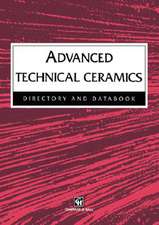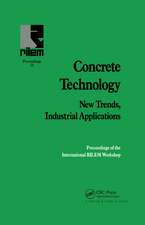Sol-Gel Nanocomposites: Advances in Sol-Gel Derived Materials and Technologies
Editat de Massimo Guglielmi, Guido Kickelbick, Alessandro Martuccien Limba Engleză Paperback – 3 sep 2016
- First comprehensive treatment of nanocomposites obtained by sol-gel methods
- Focuses on nanocomposites with inorganic and hybrid organic-inorganic matrices
- Describes design tools to optimize structure and properties for various applications
- Covers synthesis, processing, characterization, and modeling
- Uses first principles to describe the influence of interfacial characteristics on materials properties
- Presents case studies for both films and bulk applications
- Provides examples of products on the market, with descriptions of the scientific principles at the base of their success
- Includes contributions from recognized leaders in this multidisciplinary area.
Toate formatele și edițiile
| Toate formatele și edițiile | Preț | Express |
|---|---|---|
| Paperback (1) | 637.59 lei 6-8 săpt. | |
| Springer – 3 sep 2016 | 637.59 lei 6-8 săpt. | |
| Hardback (1) | 643.84 lei 6-8 săpt. | |
| Springer – 6 iul 2014 | 643.84 lei 6-8 săpt. |
Preț: 637.59 lei
Preț vechi: 750.11 lei
-15% Nou
Puncte Express: 956
Preț estimativ în valută:
122.04€ • 132.61$ • 102.58£
122.04€ • 132.61$ • 102.58£
Carte tipărită la comandă
Livrare economică 21 aprilie-05 mai
Preluare comenzi: 021 569.72.76
Specificații
ISBN-13: 9781493942169
ISBN-10: 1493942166
Pagini: 236
Ilustrații: IX, 227 p. 145 illus., 9 illus. in color.
Dimensiuni: 155 x 235 x 13 mm
Greutate: 0.34 kg
Ediția:Softcover reprint of the original 1st ed. 2014
Editura: Springer
Colecția Springer
Seria Advances in Sol-Gel Derived Materials and Technologies
Locul publicării:New York, NY, United States
ISBN-10: 1493942166
Pagini: 236
Ilustrații: IX, 227 p. 145 illus., 9 illus. in color.
Dimensiuni: 155 x 235 x 13 mm
Greutate: 0.34 kg
Ediția:Softcover reprint of the original 1st ed. 2014
Editura: Springer
Colecția Springer
Seria Advances in Sol-Gel Derived Materials and Technologies
Locul publicării:New York, NY, United States
Cuprins
General Introduction to the topic.- Nanofillers.- Host matrices.- The Role of the Interface.- Nanocomposite Formation Processes.- Nanostructure and its Characterization.- Modelling tools.- Properties.- Applications.
Textul de pe ultima copertă
This book provides comprehensive coverage of nanocomposite materials obtained by the sol-gel method, from synthesis to applications and including design tools for combining different properties. Sol-gel nanocomposites are of great interest in meeting processing and application requirements for the development of multifunctional materials. These materials are already commercialized for a number of applications from scratch-resistant and anti-adhesive coatings to optical materials with active and passive properties. Biomedical applications, holographic recordings, fuel cells and hydrogen storage, resists, and catalysts are among the potential uses. The novel mechanical, optical, and electronic properties of nanocomposite materials depend not only on the individual component materials, but also on their morphology and nanoscale interfacial characteristics. Sol-gel is a highly versatile method for obtaining both the matrix and the filler of the nanocomposite, and for chemically adjusting the interface to optimize structure and properties. Although nanocomposites are widely discussed in the literature, the focus has been mainly on polymer nanocomposites. This book addresses nanocomposites based on inorganic or hybrid organic-inorganic matrices, with an emphasis on the scientific principles which are the basis for nanocomposite sol-gel synthesis and applications. A didactic approach is followed, with different topics developed from a fundamental point of view together with key examples and case studies.
- First comprehensive treatment of nanocomposites obtained by sol-gel methods
- Focuses on nanocomposites with inorganic and hybrid organic-inorganic matrices
- Describes design tools to optimize structure and properties for various applications
- Covers synthesis, processing, characterization, and modeling
- Uses first principles to describe the influence of interfacial characteristics on materials properties
- Presents casestudies for both films and bulk applications
- Provides examples of products on the market, with descriptions of the scientific principles at the base of their success
- Includes contributions from recognized leaders in this multidisciplinary area
Caracteristici
First comprehensive treatment of nanocomposites obtained by sol-gel methods Focuses on nanocomposites with inorganic and hybrid organic-inorganic matrices Describes design tools to optimize structure and properties for various applications Covers synthesis, processing, characterization and modeling Uses first principles to describe the influence of interfacial characteristics on materials properties Includes contributions from recognized leaders in this multidisciplinary area Includes supplementary material: sn.pub/extras
































